
If you haven’t checked out the base set Sage analysis, do that now!
While decks are not required to stay “pure” colored, Sage does pretty well by itself just as a pure alignment. In fact, a pure Sage deck is pretty hard to mess up, since the cards to make a winning strategy are just so obvious. See, Sage can choose several of the winning strategies in Epic and not really lose out on anything. It can easily do freeze, simplify the game for opportunity swings, breakthrough (+blitz) on the ground, or burn, or airborne.Please be aware that Sage does not have a lot of credible threats, which means your opponent gets to advance their field more, causing you to use more spot-removal and board-wipes. The deck accounts for this as best it can by including as many threats and removal cards as possible without sacrificing synergy but ultimately every deck will have at least one weakness otherwise it won’t do anything quite well.
The basic field you’ll be going for is huge pressure with stuff like Juggernaut or Steel Golem, which rarely hit directly but have their own benefits besides. While setting up air superiority with your Avenging Angel, Djinn of the Sands, or Blue Dragon. Make sure to never have more than 2 champions on the field until you go for game. Ping with burn damage and do a few small damaging gambits while drawing as hard as possible. You’re aiming to draw into one of the following 3 finishers: Frost Giant, Ice Drake, or Deadly Raid. At that point, rack up a field, hope they don’t take the 1-turn window to board wipe (bait one early if you can) and slap down your winning-move. If you fail, wait for a board wipe and start over and try again. You should see a finisher approximately every 7 cards, meaning your opening hand might even have one. This is important because if you fail, it’s just a short 8 cards from the opening hand to another one. This deck has so much draw that it’s easy to facilitate this gambit happening 3 times in one game. If not, you can likely just use gap-play just like Good.
Another weakness of this deck is the lack of silvers. Which can also be a strength since each card from hand is going to be worth more. However, Sage can draw pretty much as much as it wants and doesn’t care about losing a few silvers. The problem is that so few really fit with the deck that it makes it very difficult to squeeze them in. There also is enough multi-color room for Corpse Taker, so you do have that going for you, especially if it gets you back Frost Giant or Ice Drake and lets you go for game.
Legend for deck keypoints:
- OPP – Counts as playable on the opponent’s turn. This is essential to keeping good rhythm and affecting game play every single turn. Doesn’t count re-usable.
- DRW – Draws at least 2 cards, or is a draw engine. Required to keep playing cards every turn including on the opponent’s turn, especially if you’re board wiping.
- OFF – In a bizarre twist of fate this includes anything the deck considers a main offensive play including freeze, burn, airborne, and so on. Getting any of these regardless of how you mix and match it will still be game-tilting.
- CTL – Removal (Control). Spot-removal used to control threats on the field and filter the opponent’s best Champions away.
- MVP – Don’t squander these as they’re your best cards.
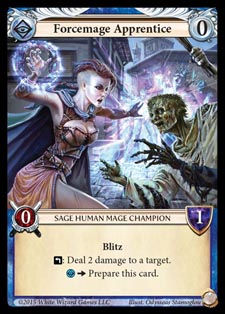
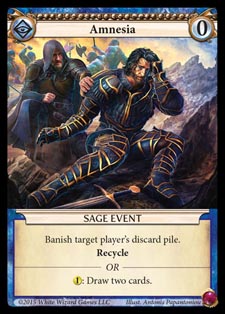





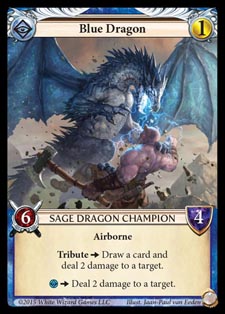

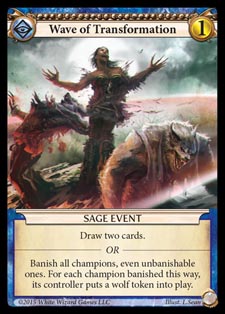
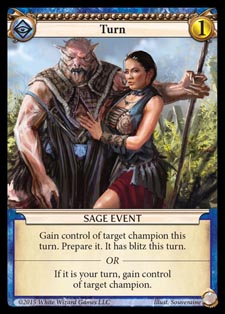
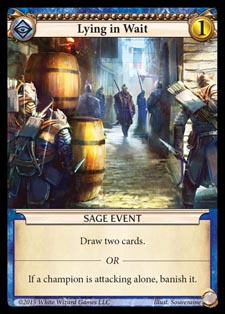


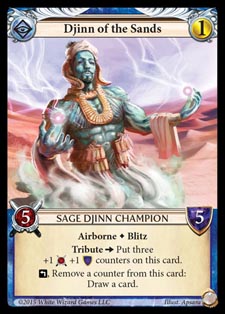


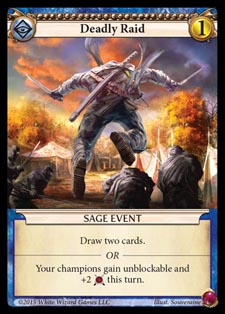


Key Point stats
Keypoint totals:
- OPP – 11 unique, 33 total cards. 55% of the deck works well on the opponent’s turn.
- OFF – 9 unique, 27 total cards. 45% of the deck is used to deal damage.
- DRW – 10 unique, 30 total cards. 50% of the deck can give net hand advantage after it’s played.
- CTL – 5 unique, 15 total cards. 25% of the deck can filter the field and answer threats.
Intersection – 175% total, spillover (intersection) of 75%. Cards, on average have 1.7 of the deck’s key points on each card. Therefore each draw in this deck has a quality rating of 1.7.
Card Changes
Right now, there are only 6 cards (10% of the deck, or 1/10 draws) that can confound loyalty/ally.
- Loyalty/Ally – 5 unique, 15 total cards. 25% of the deck requires at least two other Sages.
- Removable – 2 unique, 6 total cards. 10% of the loyals can be removed if something better is used.
- Confound – 4 unique, 12 total cards. 20% of the deck screws up 25% of the deck. Decently low screw rate but sometimes might need the 4 cards in hand to guarantee loyalty, however we have enough draw for it to be trivial.
Removable Cards:
- Steel Golem. Removable if you can find better offense and control stacked into one. Just remember that this is a less killable Rampaging Wurm, so it’s pretty risky to remove but control might be favored in this spot as the deck has a lot of offense.
- Time Bender. Basically the poor person’s High King/Dark Assassin but for Sage. Nevertheless, it does do its job, albeit at a less permanent value. Removable as long as more control replaces it.
- Amnesia. It’s a pretty optional silver mostly here for the draw, banish control and a cool combo with Zombie Apocalypse. You can put anything that will fit here especially Keeper of Secrets. If you somehow get 6 more Evils, Thrasher Demon is something you can’t go wrong with as it usually draws gold advantage.
- Lying in Wait. If you get rid of this, I highly suggest Stand Alone. This made it in since we usually go for draw or removal on the opponent’s turn anyway and try to play something like a threat or flash on our own turn. If you feel that there is a lack of board-wipes in your meta, go for Stand Alone as it will make keeping your progress easier and you can deal with whatever they have left usually.
Enough about what the deck isn’t, here’s what it is: A crush-rushing aggro as hell Sage deck. I bet you didn’t see that one coming. We’re abusing the ridiculous library of offensive champions Sage has access to with the equally-stupid access to direct attacks and damage. While we’re at it, our hand will usually never go below 4, often staying around 6-7 in my experience. You can blindly play right into board wipes no problem as long as your champions are getting something extra when they come into play (flashes). You almost always have the right answer in any situation too. This deck seems to wreck the pants off of Good, go about even with my Evil and Wild decks. Whether that’s because I’ve built a good Sage deck or bad other decks I can’t really say but nevetheless this is your signature aggro Sage deck.
As discussed in the Sage alignment analysis, it can easily go toe-to toe with Good’s airborne, beats all other airborne, and beats the bodies of both Good and Evil. Its biggest problems are the lack of threat targets to stave off spot-removal of its attackers, lack of silvers for multi-play turns, and difficult time sometimes dealing with wide Token spam swings unless you run Lying in Wait and some more board-wipes.

Leave a comment